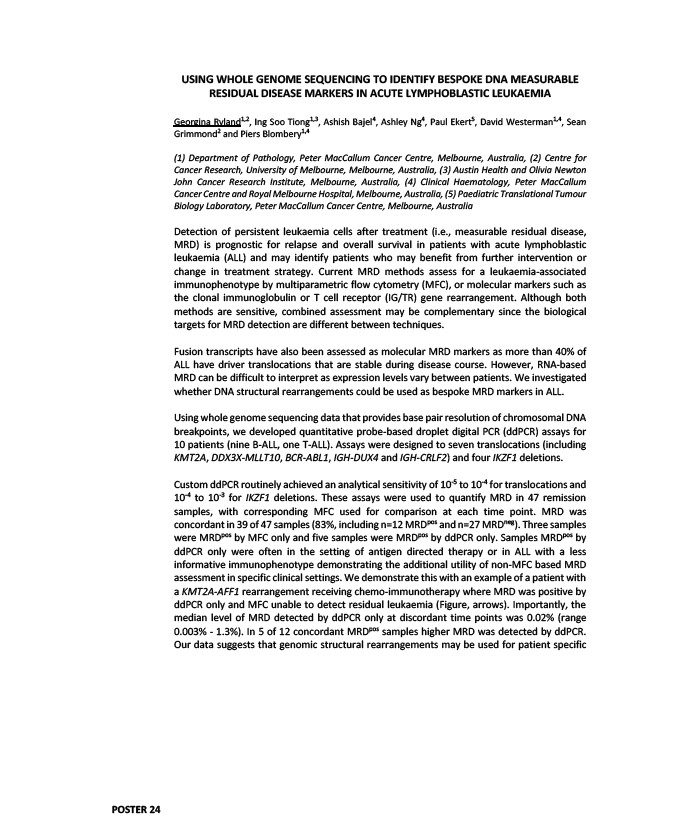
USING WHOLE GENOME SEQUENCING TO IDENTIFY BESPOKE DNA MEASURABLE
RESIDUAL DISEASE MARKERS IN ACUTE LYMPHOBLASTIC LEUKAEMIA
Georgina Ryland1,2, Ing Soo Tiong1,3, Ashish Bajel4, Ashley Ng4, Paul Ekert5, David Westerman1,4, Sean
Grimmond2 and Piers Blombery1,4
(1) Department of Pathology, Peter MacCallum Cancer Centre, Melbourne, Australia, (2) Centre for
Cancer Research, University of Melbourne, Melbourne, Australia, (3) Austin Health and Olivia Newton
John Cancer Research Institute, Melbourne, Australia, (4) Clinical Haematology, Peter MacCallum
Cancer Centre and Royal Melbourne Hospital, Melbourne, Australia, (5) Paediatric Translational Tumour
Biology Laboratory, Peter MacCallum Cancer Centre, Melbourne, Australia
Detection of persistent leukaemia cells after treatment (i.e., measurable residual disease,
MRD) is prognostic for relapse and overall survival in patients with acute lymphoblastic
leukaemia (ALL) and may identify patients who may benefit from further intervention or
change in treatment strategy. Current MRD methods assess for a leukaemia-associated
immunophenotype by multiparametric flow cytometry (MFC), or molecular markers such as
the clonal immunoglobulin or T cell receptor (IG/TR) gene rearrangement. Although both
methods are sensitive, combined assessment may be complementary since the biological
targets for MRD detection are different between techniques.
Fusion transcripts have also been assessed as molecular MRD markers as more than 40% of
ALL have driver translocations that are stable during disease course. However, RNA-based
MRD can be difficult to interpret as expression levels vary between patients. We investigated
whether DNA structural rearrangements could be used as bespoke MRD markers in ALL.
Using whole genome sequencing data that provides base pair resolution of chromosomal DNA
breakpoints, we developed quantitative probe-based droplet digital PCR (ddPCR) assays for
10 patients (nine B-ALL, one T-ALL). Assays were designed to seven translocations (including
KMT2A, DDX3X-MLLT10, BCR-ABL1, IGH-DUX4 and IGH-CRLF2) and four IKZF1 deletions.
Custom ddPCR routinely achieved an analytical sensitivity of 10-5 to 10-4 for translocations and
10-4 to 10-3 for IKZF1 deletions. These assays were used to quantify MRD in 47 remission
samples, with corresponding MFC used for comparison at each time point. MRD was
concordant in 39 of 47 samples (83%, including n=12 MRDpos and n=27 MRDneg). Three samples
were MRDpos by MFC only and five samples were MRDpos by ddPCR only. Samples MRDpos by
ddPCR only were often in the setting of antigen directed therapy or in ALL with a less
informative immunophenotype demonstrating the additional utility of non-MFC based MRD
assessment in specific clinical settings. We demonstrate this with an example of a patient with
a KMT2A-AFF1 rearrangement receiving chemo-immunotherapy where MRD was positive by
ddPCR only and MFC unable to detect residual leukaemia (Figure, arrows). Importantly, the
median level of MRD detected by ddPCR only at discordant time points was 0.02% (range
0.003% - 1.3%). In 5 of 12 concordant MRDpos samples higher MRD was detected by ddPCR.
Our data suggests that genomic structural rearrangements may be used for patient specific
POSTER 24